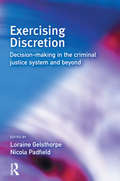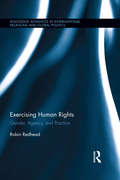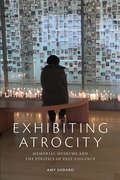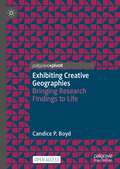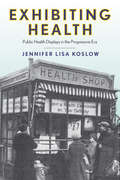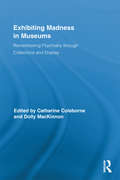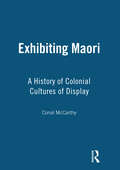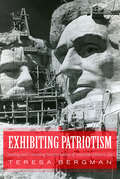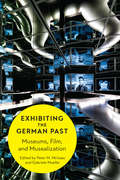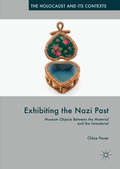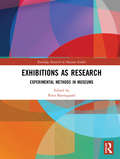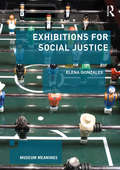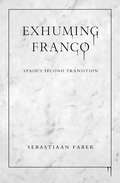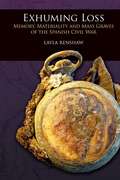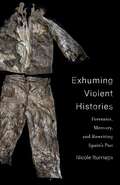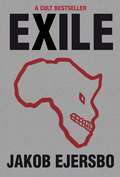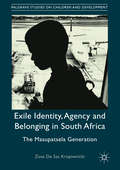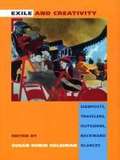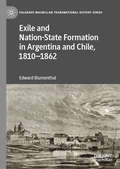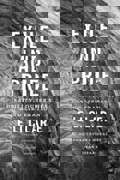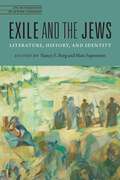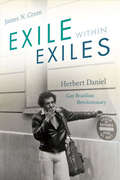- Table View
- List View
Exercising Discretion
by Loraine Gelsthorpe Nicola PadfieldThe exercise of discretion in the criminal justice system and related agencies often plays a key part in decisions which are made, but definitions of discretion are not clear, and despite widespread recognition of its importance there is much controversy on its nature and legitimacy. This book seeks to explore the importance of discretion to an understanding of the nature of the 'making of justice' in theory and practice, taking as its starting point the wide discretionary powers wielded by many of the key players in the criminal justice and related systems. It focuses on the core elements and contexts of discretion, looking at the power, ability, authority and duties of individuals, officials and organisations to decide, select or interpret vague standards, requirements or statutory uncertainties.
Exercising Human Rights: Gender, Agency and Practice (Routledge Advances in International Relations and Global Politics)
by Robin RedheadExercising Human Rights investigates why human rights are not universally empowering and why this damages people attempting to exercise rights. It takes a new approach in looking at humans as the subject of human rights rather than the object and exposes the gendered and ethnocentric aspects of violence and human subjectivity in the context of human rights. Using an innovative visual methodology, Redhead shines a new critical light on human rights campaigns in practice. She examines two cases in-depth. First, she shows how Amnesty International depicts women negatively in their 2004 ‘Stop Violence against Women Campaign’, revealing the political implications of how images deny women their agency because violence is gendered. She also analyses the Oka conflict between indigenous people and the Canadian state. She explains how the Canadian state defined the Mohawk people in such a way as to deny their human subjectivity. By looking at how the Mohawk used visual media to communicate their plight beyond state boundaries, she delves into the disjuncture between state sovereignty and human rights. This book is useful for anyone with an interest in human rights campaigns and in the study of political images.
Exhibiting Atrocity: Memorial Museums and the Politics of Past Violence
by Amy SodaroToday, nearly any group or nation with violence in its past has constructed or is planning a memorial museum as a mechanism for confronting past trauma, often together with truth commissions, trials, and/or other symbolic or material reparations. Exhibiting Atrocity documents the emergence of the memorial museum as a new cultural form of commemoration, and analyzes its use in efforts to come to terms with past political violence and to promote democracy and human rights. Through a global comparative approach, Amy Sodaro uses in-depth case studies of five exemplary memorial museums that commemorate a range of violent pasts and allow for a chronological and global examination of the trend: the U.S. Holocaust Memorial Museum in Washington, DC; the House of Terror in Budapest, Hungary; the Kigali Genocide Memorial Centre in Rwanda; the Museum of Memory and Human Rights in Santiago, Chile; and the National September 11 Memorial Museum in New York. Together, these case studies illustrate the historical emergence and global spread of the memorial museum and show how this new cultural form of commemoration is intended to be used in contemporary societies around the world.
Exhibiting Creative Geographies: Bringing Research Findings to Life
by Candice P. BoydThis open access book provides a detailed example of arts-based knowledge translation from start to finish for any scholar interested in communicating research findings through art. Firmly grounded in the GeoHumanities, a field at the intersection of cultural geography and the arts, this book explores the theory and practice of research exhibitions. Commencing with an overview of arts in health and art-science collaborations, this book also explores the concept of ‘affective knowledge translation’. In doing so, it describes the creative co-production, staging, and evaluation of the Finding Home exhibition which toured Australia during 2021. As a demonstration of the power of art to engage audiences, raise awareness of social issues, communicate lived experience, and extend the reach of cultural geographic research, this book is relevant to academics from any discipline who are keen to increase the societal impact of their work.
Exhibiting Health: Public Health Displays in the Progressive Era (Critical Issues in Health and Medicine)
by Jennifer Lisa KoslowIn the early twentieth century, public health reformers approached the task of ameliorating unsanitary conditions and preventing epidemic diseases with optimism. Using exhibits, they believed they could make systemic issues visual to masses of people. Embedded within these visual displays were messages about individual action. In some cases, this meant changing hygienic practices. In other situations, this meant taking up action to inform public policy. Reformers and officials hoped that exhibits would energize America's populace to invest in protecting the public's health. Exhibiting Health is an analysis of the logic of the production and the consumption of this technique for popular public health education between 1900 and 1930. It examines the power and limits of using visual displays to support public health initiatives.
Exhibiting Madness in Museums: Remembering Psychiatry Through Collection and Display (Routledge Research in Museum Studies)
by Catharine Coleborne Dolly MacKinnonWhile much has been written on the history of psychiatry, remarkably little has been written about psychiatric collections or curating. Exhibiting Madness in Museums offers a comparative history of independent and institutional collections of psychiatric objects in Australia, New Zealand, Canada and the United Kingdom. Leading scholars in the field investigate collectors, collections, their display, and the reactions to exhibitions of the history of insanity. Linked to the study of medical museums this work broadens the study of the history of psychiatry by investigating the significance and importance of the role of twentieth-century psychiatric communities in the preservation, interpretation and representation of the history of mental health through the practice of collecting. In remembering the asylum and its different communities in the twentieth century, individuals who lived and worked inside an institution have struggled to preserve the physical character of their world. This collection of essays considers the way that collections of objects from the former psychiatric institution have played a role in constructions of its history. It historicises the very act of collecting, and also examines ethical problems and practices which arise from these activities for curators and exhibitions.
Exhibiting Maori: A History of Colonial Cultures of Display
by Conal McCarthyThis richly illustrated book presents a comprehensive assessment of the display of Maori culture from the nineteenth century to today. In doing so, Exhibiting Maori traces the long journey from curio to specimen, artefact, art and taonga (treasure). Drawing on extensive and groundbreaking research, Exhibiting Maori reveals for the first time the remarkable story of Maori resistance to, involvement in, and eventual capture of the display of their culture.Ranging across museums, world fairs, fine art and tourism, Exhibiting Maori fuses museum studies, anthropology, and visual and material culture to uncover a history of active Maori engagement with the colonial culture of display.
Exhibiting Patriotism: Creating and Contesting Interpretations of American Historic Sites
by Teresa BergmanAmerican nationalism, patriotism and citizenship are proudly on display at historical sites across America—but they are also contested and reshaped by visitors and their engagement with those places. In Exhibiting Patriotism, Bergman analyzes exhibits, interpretive materials, and orientation films at major US sites, from Mt. Rushmore and to the USS Arizona Memorial, where controversy has erupted over the stories they tell about the past. She shows how historic narratives are the result of dynamic relationships between institutions and the public, and how these relationships are changing in an era when museums are becoming more visitor-centered, seeing visitors as partners in historical interpretation. Drawing on film theory, memory studies, visual communication, and visitor studies, Bergman offers an important analysis for scholars and professionals in American studies, museum studies, public history, and communication and media studies.
Exhibiting the German Past
by Peter M. Mcisaac Gabriele MuellerWhile scholars recognize both museums and films as sites where historical knowledge and cultural memory are created, the convergence between their methods of constructing the past has only recently been acknowledged. The essays in Exhibiting the German Past examine a range of films, museums, and experiences which blend the two, considering how authentic objects and cinematic techniques are increasingly used in similar ways by both visual media and museums.This is the first collection to focus on the museum-film connection in German-language culture and the first to approach the issue using the concept of "musealization," a process that, because it engages the cultural destruction wrought by modernization, offers new means of constructing historical knowledge and shaping collective memory within and beyond the museum's walls. Featuring a wide range of valuable case studies, Exhibiting the German Past offers a unique perspective on the developing relationship between museums and visual media.
Exhibiting the Nazi Past: Museum Objects Between the Material and the Immaterial (The Holocaust and its Contexts)
by Chloe PaverThis book is the first full-length study of the museum object as a memory medium in history exhibitions about the Nazi era, the Second World War, and the Holocaust. Over recent decades, German and Austrian exhibition-makers have engaged in significant programmes of object collection, often in collaboration with witnesses and descendants. At the same time, exhibition-makers have come to recognise the degree to which the National Socialist era was experienced materially, through the loss, acquisition, imposition, destruction, and re-purposing of objects. In the decades after 1945, encounters with material culture from the Nazi past continued, both within the family and in the public sphere. In analysing how these material engagements are explored in the museum, the book not only illuminates a key aspect of German and Austrian cultural memory but contributes to wider debates about relationships between the human and object worlds.
Exhibitions as Research: Experimental Methods in Museums (Routledge Research in Museum Studies)
by Peter BjerregaardExhibitions as Research contends that museums would be more attractive to both researchers and audiences if we consider exhibitions as knowledge-in-the-making rather than platforms for disseminating already-established insights. Analysing the theoretical underpinnings and practical challenges of such an approach, the book questions whether it is possible to exhibit knowledge that is still in the making, whilst also considering which concepts of "knowledge" apply to such a format. The book also considers what the role of audience might be if research is extended into the exhibition itself. Providing concrete case studies of projects where museum professionals have approached exhibition making as a knowledge-generating process, the book considers tools of application and the challenges that might emerge from pursuing such an approach. Theoretically, the volume analyses the emergence of exhibitions as research as part of recent developments within materiality theories, object-oriented ontology and participatory approaches to exhibition-making. Exhibitions as Research will be of interest to academics and students engaged in the study of museology, material culture, anthropology and archaeology. It will also appeal to museum professionals with an interest in current trends in exhibition-making.
Exhibitions for Social Justice (Museum Meanings)
by Elena GonzalesExhibitions for Social Justice assesses the state of curatorial work for social justice in the Americas and Europe today. Analyzing best practices and new curatorial work to support all those working on exhibitions, Gonzales expounds curatorial practices that lie at the nexus of contemporary museology and neurology. From sharing authority, to inspiring action and building solidarity, the book demonstrates how curators can make the most of visitors’ physical and mental experience of exhibitions. Drawing on ethnographic and archival work at over twenty institutions with nearly eighty museum professionals, as well as scholarship in the public humanities, visual culture, cultural studies, memory studies, and brain science, this project steps back from the detailed institutional histories of how exhibitions come to be. Instead, it builds a set of curatorial practices by examining the work behind the finished product in the gallery. Demonstrating that museums have the power to help our society become more hospitable, equitable, and sustainable, Exhibitions for Social Justice will be of interest to scholars and students of museum and heritage studies, gallery studies, arts and heritage management, and politics. It will also be valuable reading for museum professionals and anyone else working with exhibitions who is looking for guidance on how to ensure their work attains maximum impact.
Exhuming Franco: Spain's Second Transition, Second Edition
by Sebastiaan FaberThrough dozens of interviews, intensive reporting, and deep research and analysis, Sebastiaan Faber sets out to understand what remains of Francisco Franco's legacy in Spain today. Faber's work is grounded in heavy scholarship, but the book is an engaging, accessible introduction to a national conversation about fascism. Spurred by the disinterment of the dictator in 2019, Faber finds that Spain is still deeply affected—and divided—by the dictatorial legacies of Francoism. This new edition, with additional interviews and a new introduction, illuminates the dangers of the rise of right-wing nationalist revisionism by using Spain as a case study for how nations face, or don't face, difficult questions about their past.
Exhuming Loss: Memory, Materiality and Mass Graves of the Spanish Civil War (UCL Institute of Archaeology Critical Cultural Heritage Series)
by Layla RenshawThis book examines the contested representations of those murdered during the Spanish Civil War of the 1930s in two small rural communities as they undergo the experience of exhumation, identification, and reburial from nearby mass graves. Based on interviews with relatives of the dead, community members and forensic archaeologists, it pays close attention to the role of excavated objects and images in breaking the pact of silence that surrounded the memory of these painful events for decades afterward. It also assesses the significance of archaeological and forensic practices in changing relationships between the living and dead. The exposure of graves has opened up a discursive space in Spanish society for multiple representations to be made of the war dead and of Spain’s traumatic past.
Exhuming Violent Histories: Forensics, Memory, and Rewriting Spain’s Past
by Nicole IturriagaMany years after the fall of Franco’s regime, Spanish human rights activists have turned to new methods to keep the memory of state terror alive. By excavating mass graves, exhuming remains, and employing forensic analysis and DNA testing, they seek to provide direct evidence of repression and break through the silence about the dictatorship’s atrocities that persisted well into Spain’s transition to democracy.Nicole Iturriaga offers an ethnographic examination of how Spanish human rights activists use forensic methods to challenge dominant histories, reshape collective memory, and create new forms of transitional justice. She argues that by grounding their claims in science, activists can present themselves as credible and impartial, helping them intervene in fraught public disputes about the remembrance of the past. The perceived legitimacy and authenticity of scientific techniques allows their users to contest the state’s historical claims and offer new narratives of violence in pursuit of long-delayed justice.Iturriaga draws on interviews with technicians and forensics experts and provides a detailed case study of Spain’s best-known forensic human rights organization, the Association for the Recovery of Historical Memory. She also considers how the tools and tactics used in Spain can be adopted by human rights and civil society groups pursuing transitional justice in other parts of the world. An ethnographically rich account, Exhuming Violent Histories sheds new light on how science and technology intersect with human rights and collective memory.
Exile
by Jakob EjersboFor the vagabond pack of ex-pat Europeans, Indian Tanzanians and wealthy Africans at Moshi's International School, it's all about getting high, getting drunk and getting laid. Their parents - drug dealers, mercenaries and farmers gone to seed - are too dead inside to give a damn. Outwardly free but empty at heart, privileged but out of place, these kids are lost, trapped in a land without hope. They can try to get out, but something will always drag them back - where can you go when you believe in nothing and belong to nowhere? Exile is the first of three powerful novels about growing up as an ex-pat in Tanzania. Ejersbo's first novel, Nordkraft, the Danish Trainspotting, was a phenomenal bestseller. Ejersbo's trilogy, only published after his death in 2008, has proved to be another cult and critical sensation.
Exile (The Africa Trilogy)
by Jakob EjersboFor the vagabond pack of ex-pat Europeans, Indian Tanzanians and wealthy Africans at Moshi's International School, it's all about getting high, getting drunk and getting laid. Their parents - drug dealers, mercenaries and farmers gone to seed - are too dead inside to give a damn. Outwardly free but empty at heart, privileged but out of place, these kids are lost, trapped in a land without hope. They can try to get out, but something will always drag them back - where can you go when you believe in nothing and belong to nowhere? Exile is the first of three powerful novels about growing up as an ex-pat in Tanzania. Ejersbo's first novel, Nordkraft, the Danish Trainspotting, was a phenomenal bestseller. Ejersbo's trilogy, only published after his death in 2008, has proved to be another cult and critical sensation.
Exile And Pride: Disability, Queerness and Liberation
by Eli ClareExile and Pride is a call to awareness, an exhortation for each of us to examine our connection to and alienation from our environment, our sexuality, and each other.
Exile Identity, Agency and Belonging in South Africa
by Zosa De Sas KropiwnickiThis book examines the experiences of 49 second-generation exiles from South Africa. Using “generation” as an analytical concept, it investigates the relational, temporal and embodied nature of their childhoods in terms of kinship relations, life cycle, cohort development and memory-making. It reveals how child agents exploited the liminal nature of exile to negotiate their sense of identity, home and belonging, while also struggling over their position and power in formal Politics and informal politics of the everyday. It also reflects upon their political consciousness, identity and sense of civic duty on return to post-apartheid South Africa, and how this has led to the emergence of the Masupatsela generational cohort concerned with driving social and political change in South Africa.
Exile and Creativity: Signposts, Travelers, Outsiders, Backward Glances
by Susan Rubin SuleimanA major historical phenomenon of our century, exile has been a focal point for reflections about individual and cultural identity and problems of nationalism, racism, and war. Whether emigrés, exiles, expatriates, refugees, or nomads, these people all experience a distance from their homes and often their native languages. Exile and Creativity brings together the widely varied perspectives of nineteen distinguished European and American scholars and cultural critics to ask: Is exile a falling away from a source of creativity associated with the wholeness of home and one's own language, or is it a spur to creativity?In essays that range chronologically from the Renaissance to the 1990s, geographically from the Danube to the Andes, and historically from the Inquisition to the Holocaust, the complexities and tensions of exile and the diversity of its experiences are examined. Recognizing exile as an interior experience as much as a physical displacement, this collection discusses such varied topics as intellectual exile and seventeenth-century French literature; different versions of home and of the novel in the writings of Bakhtin and Lukács; the displacement of James Joyce and Clarice Lispector; a young journalist's meeting with James Baldwin in the south of France; Jean Renoir's Hollywood years; and reflections by the descendents of European emigrés. Strikingly, many of the essays are themselves the work of exiles, bearing out once more the power of the personal voice in scholarship.With the exception of the contribution by Henry Louis Gates Jr., these essays were originally published in a special double issue of Poetics Today in 1996. Exile and Creativity will engage a range of readers from those whose specific interests include the problems of displacement and diaspora and the European Holocaust to those whose broad interests include art, literary and cultural studies, history, film, and the nature of human creativity.Contributors. Zygmunt Bauman, Janet Bergstrom, Christine Brooke-Rose, Hélène Cixous, Tibor Dessewffy, Marianne Hirsch, Denis Hollier, Henry Louis Gates Jr., Linda Nochlin, Leo Spitzer, Susan Rubin Suleiman, Thomas Pavel, Doris Sommer, Nancy Huston, John Neubauer, Ernst van Alphen, Alicia Borinsky, Svetlana Boym, Jacqueline Chénieux-Gendron
Exile and Nation-State Formation in Argentina and Chile, 1810–1862 (Palgrave Macmillan Transnational History Series)
by Edward BlumenthalThis book traces the impact of exile in the formation of independent republics in Chile and the Río de la Plata in the decades after independence. Exile was central to state and nation formation, playing a role in the emergence of territorial borders and Romantic notions of national difference, while creating a transnational political culture that spanned the new independent nations. Analyzing the mobility of a large cohort of largely elite political émigrés from Chile and the Río de la Plata across much of South America before 1862, Edward Blumenthal reinterprets the political thought of well-known figures in a transnational context of exile. As Blumenthal shows, exile was part of a reflexive process in which elites imagined the nation from abroad while gaining experience building the same state and civil society institutions they considered integral to their republican nation-building projects.
Exile and Pride: Disability, Queerness, and Liberation
by Eli ClareFirst published in 1999, the groundbreaking Exile and Pride is essential to the history and future of disability politics. Eli Clare's revelatory writing about his experiences as a white disabled genderqueer activist/writer established him as one of the leading writers on the intersections of queerness and disability and permanently changed the landscape of disability politics and queer liberation. With a poet's devotion to truth and an activist's demand for justice, Clare deftly unspools the multiple histories from which our ever-evolving sense of self unfolds. <P><P>His essays weave together memoir, history, and political thinking to explore meanings and experiences of home: home as place, community, bodies, identity, and activism. Here readers will find an intersectional framework for understanding how we actually live with the daily hydraulics of oppression, power, and resistance. At the root of Clare's exploration of environmental destruction and capitalism, sexuality and institutional violence, gender and the body politic, is a call for social justice movements that are truly accessible to everyone. With heart and hammer, Exile and Pride pries open a window onto a world where our whole selves, in all their complexity, can be realized, loved, and embraced.
Exile and the Jews: Literature, History, and Identity (JPS Anthologies of Jewish Thought)
by Marc Saperstein Nancy E. BergThis first comprehensive anthology examining Jewish responses to exile from the biblical period to our modern day gathers texts from all genres of Jewish literary creativity to explore how the realities and interpretations of exile have shaped Judaism, Jewish politics, and individual Jewish identity for millennia. Ordered along multiple arcs—from universal to particular, collective to individual, and mythic-symbolic to prosaic everyday living—the chapters present different facets of exile: as human condition, in history and life, in holiday rituals, in language, as penance and atonement, as internalized experience, in relation to the Divine Presence, and more. By illuminating the multidimensional nature of &“exile&”—political, philosophical, religious, psychological, and mythological—widely divergent evaluations of Jewish life in the Diaspora emerge. The word &“exile&” and its Hebrew equivalent, galut, evoke darkness, bleakness—and yet the condition offers spiritual renewal and engenders great expressions of Jewish cultural creativity: the Babylonian Talmud, medieval Jewish philosophy, golden age poetry, and modern Jewish literature.Exile and the Jews will engage students, academics, and general readers in contemplating immigration, displacement, evolving identity, and more.
Exile through a Gendered Lens: Women’s Displacement in Recent European History, Literature, and Cinema
by Gesa Zinn Maureen Tobin StanleyThis interdisciplinary anthology highlights exiled/alienated women in literature, history, and cinema. Contributors investigate when and how women from diverse backgrounds have been relegated to the margins in order to shed light on the state of alienhood that stems from gendered otherness.
Exile within Exiles: Herbert Daniel, Gay Brazilian Revolutionary
by James N. GreenHerbert Daniel was a significant and complex figure in Brazilian leftist revolutionary politics and social activism from the mid-1960s until his death in 1992. As a medical student, he joined a revolutionary guerrilla organization but was forced to conceal his sexual identity from his comrades, a situation Daniel described as internal exile. After a government crackdown, he spent much of the 1970s in Europe, where his political self-education continued. He returned to Brazil in 1981, becoming engaged in electoral politics and social activism to champion gay rights, feminism, and environmental justice, achieving global recognition for fighting discrimination against those with HIV/AIDS. In Exile within Exiles, James N. Green paints a full and dynamic portrait of Daniel's deep commitment to leftist politics, using Daniel's personal and political experiences to investigate the opposition to Brazil's military dictatorship, the left's construction of a revolutionary masculinity, and the challenge that the transition to democracy posed to radical movements. Green positions Daniel as a vital bridge linking former revolutionaries to the new social movements, engendering productive dialogue between divergent perspectives in his writings and activism.
